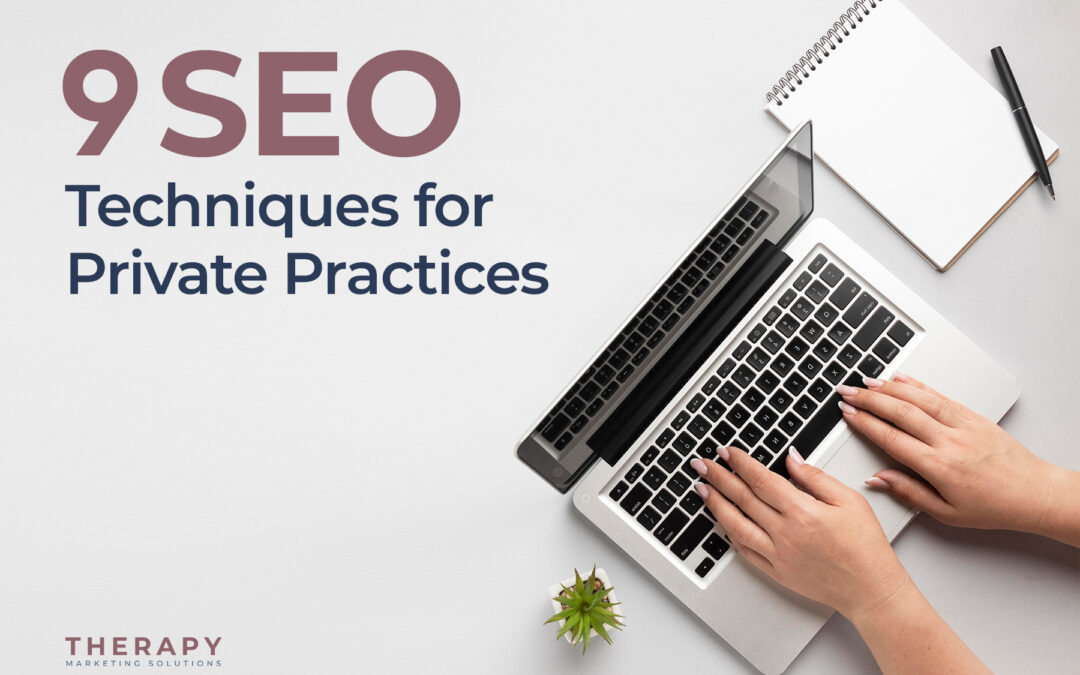When setting up your private practice, much of your efforts to bring new clients through the doors are dependent on your marketing efforts. One of the most important aspects of productive marketing efforts is having the proper Search Engine Optimization (SEO) strategies in place.
SEO is time and effort-consuming, but when done right, there is no looking back. It helps you attract the right kind of audience, your ideal clients.
Understanding Search Engine Optimization (SEO)
When you search for anything online, a result page shows you websites related to your search. Now, why does one website show on top of another? While other websites don’t even appear on the search results? Search Engine Optimization is what drives the results that appear on your results page.
Optimizing your digital assets like your website and dynamic content like blogs is known as SEO. When you do this, search engines like Google, Bing, Yahoo, etc. and understand your business, who you are, and what you do. Once the search engines get this information, they start showing your information to people looking for it.
Since SEO helps you appear in front of people looking for therapists like you, it is important to ensure that you know and implement the best SEO practices. Also, since people looking for therapy for themselves or their loved ones prefer to do an online search before booking a session, it becomes all the more crucial to invest your time, effort, and money into optimizing your digital presence through SEO.
In the era of ads, does SEO really matter?
It is pretty straightforward. Ads work and will give you results while you pay. However, when you stop investing money in paid advertisements, you no longer appear on the initial search result pages. Ads are a lot like a light switch. You will be found when the light is shining bright, but once you stop paying the bill, the lights go off, and no one knows you are there any longer.
Besides being organic (free), SEO has a longer-lasting effect than paid ads. Yes, SEO takes a little time to show results and move you up the ranks to a decent standing on the search results page, but you can depend on SEO for a longer term.
Check out why SEO could be a good fit for your private practice:
- SEO helps you get in front of people looking for someone just like you, so the chances of getting clients are higher.
- SEO increases traffic on your website and conversion rate (buying a product, service, or filling out a form) while working on reducing bounce rates (visiting your site but not converting. Think of it as “I jumped into your site, didn’t like it, and bounced out”).
- When you optimize your website and your blogs, you establish your expertise in your field of practice, which helps you build trust among potential clients.
- When your private practice grows, you can add more therapists by showing that your clinic ranks well on Google, which will help your business grow.
The benefits that SEO brings with it are too many to count. A Huffington Post article effectively captures the essence of this crucial aspect of marketing, exclaiming, “The best place to hide a dead body is page 2 of Google search results.”
Now that you know it is essential, let’s discuss 9 SEO techniques for private practices:
1. Selecting the right set of keywords
Choose keywords that your potential clients would be in search of. For instance, if you deal with depression and specialize in therapy for teenagers, then choose “depression” as the primary keyword and “depression in teenagers” as the secondary keyword.
When choosing the keywords, aim for those with high search volume and low competition, as getting a good rank for such keywords is easier. There are free tools for helping you choose keywords. Here are just a few:
To help you better understand how to find keywords, here are a couple articles from some of the top SEO professionals:
- Backlinko: Definitive Guide Keyword Research
- SemRush: How to Do Keyword Research for SEO
- The Digital XX: The Most Effective Way of Doing Keyword Research
2. Build internal links
Write content for your website in such a way that you can link one blog or article to the home page. This will keep website visitors engaged while they move from one page to another.
3. External Linking (Backlinking)
The goal of backlinking is to have other professionals link their sites to yours. A long yet sustainable method of accomplishing this is to create relationships with other bloggers within your industry, by being a guest writer on their site or being a guest on their podcast. When you provide other bloggers with valuable content, they’ll consider you a subject matter expert and link to your site from their blog.
Another technique is creating displays, i.e. graphs, showing stats or useful information on your site. People like images and numbers. If they see a well-created display, they’ll link to it from their site or blog. You are providing the customer with valuable content at the same time attracting backlinks.
When Google sees multiple links to your site– it gives you “street cred,” and your rankings will go up. This is considered by most SEO experts, as one of the fastest ways to move to the top of the pages.
4. Keep your content story-based
The rule of thumb suggests that a webpage should have a minimum content of 250 words. However, per SEO standards, the minimum number of words is 450.
Does that seem like a lot of text on a page? Yes, but here’s the solution.
Instead of just writing a few bland paragraphs about your services, invite them into a story of what life could look like after working with you. Keep the story in mind while inserting keywords in between. This will keep readers engaged, differentiate you from your competitors, and get them excited about working with you.
While inserting keywords into your content, keep it natural and be careful not to stuff the keywords. Typically no more than 2-3 keywords per page. Stuffing keywords makes it look forced and will dilute the content, sometimes to the extent that the story will no longer make sense. Not only does it create a bad user experience, but Google will pick up on it and could penalize your site.
5. Structure your content on every webpage
Give your content a structure by inserting related images wherever possible in between text and using bullets to grab your reader’s attention to the main highlights.
6. Choose the correct title tag
Title tags are like an introduction pitch that tells the search engine what your individual web pages are about. Use a maximum of 70 characters to write the title tags, including spaces. Insert keywords naturally in the title tag and never duplicate a title, even if the content on the web pages are similar.
Here’s a couple great articles from leading SEO professionals to assist you with Title Tags and Meta Descriptions
7. List your practice in online directories
Listing your private therapy practice on well-known and reliable directories helps to enhance your website’s SEO performance. Include a link to your website in your listing to be easily found by the directory visitors.
8. Local SEO
Local SEO has a significant impact on your website’s performance and helps you to tie in with your niche. For example, users often search for “therapists near me,” it is essential to provide information to search engines about where you are located.
A starting point is to include your contact information on all your website’s pages.
If you are interested in learning more, here are a couple of great articles by leading SEO professionals:
9. Track what works for you
From the day you start investing in SEO strategies, ensure that you closely track what is working and what is not. SEO analysis tools like Google Analytics are great for measuring your performance and building on it accordingly.
This link will take you directly to Google’s Free Courses on Analytics to help you set it up and how to use it. Note: select Google Analytics 4 (GA4). Universal Analytics is being replaced by GA4
Final words
Search engine algorithms change all the time. So, it is essential to stay up-to-date regarding recent SEO trends and modify your efforts accordingly.
SEO is not a one-time thing. It is part of a larger marketing strategy. If done correctly, that will increase website traffic, attract the right audience, and build authority for your business. In turn, bringing growth to your private practice by bringing in additional clients.


